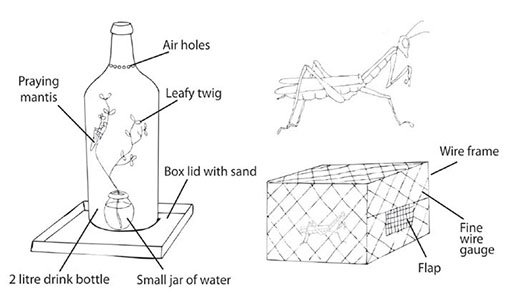Resource 3: Keeping a preying mantis in the classroom
![]() Background information / subject knowledge for teacher
Background information / subject knowledge for teacher
Keeping a preying mantis as a temporary guest in the classroom is very easy. The larger ones with bigger abdomens (full of eggs) and shorter feelers are the females. The thinner more delicate ones with longer feelers are the males. They are better adapted to flying in search of females. The females tend to stay on the same plant and wait for males to approach them.
It shouldn’t be difficult for pupils to catch one in a plastic bag. A good cage can be made using wire gauze over a wooden or stiff wire frame. What also works well is to cut off the bottom of a clear plastic 2-litre cool drink bottle. Make a series of holes near the top using a sharp nail to let in air. Put some sand into the lid of a box and stand a leafy twig in a small jar of water (see diagram below). Trap the preying mantis under the bottle and use the screw-on cap to put in a regular supply of small, live insects such as flies, moths and grasshoppers. The pupils will enjoy watching the mantis trap and eat its prey.
If you have a male and a female in the same container they may well mate, but be prepared for a bit of drama. The female will usually lean back and start to cannibalise the male once mating has taken place.
After mating, you might see the female laying her eggs in two neat rows in a frothy substance that soon dries and hardens and is paper-like. Release the female after a while. Keep the egg case under observation and your pupils might be lucky enough to witness the hatching of the tiny, blackish preying mantis nymphs. They need to be released, as it isn’t easy to feed them in captivity, but notice how the abdomen is curled up over the back in a characteristic way.

Resource 2: Likely local ecosystems



